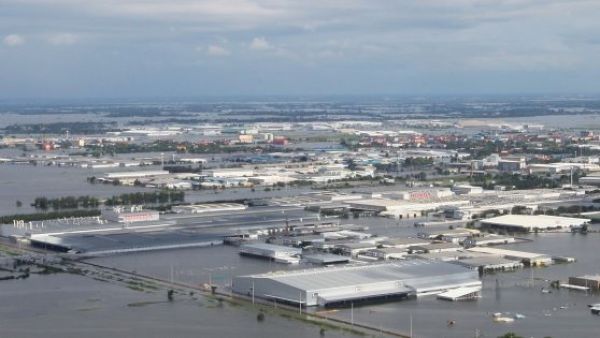Businesses also incur massive human and economic costs during natural disasters. They can reduce these costs by diversifying geographically and technologically.
The devastating human cost of natural disasters cannot be overstated, and rightly receives the lion’s share of media and academic attention on the subject. There is, however, one aspect of the impact of natural disasters that has been little studied: the impact on businesses.
For example, flooding in Bangkok in 2011 disrupted Thailand's automotive and hard drive industries to such a degree that production did not recover until 2012. For hard drive manufacturer Western Digital alone, losses from the flooding amounted to US$225–275 million. So how can companies mitigate the impact of these unpredictable but unavoidable events?
Diversifying Production Locations
Many companies are not aware of the importance of preparing for natural disasters, due to a lack of large-scale analyses of the impact of such events. Based on US data, recent research shows that manufacturing companies affected by natural disasters have returns on assets (ROA) lowered by up to two percentage points. This figure reveals the need for companies to carefully plan their operations to alleviate disruption risks.
How can they go about this? One possible route is geographic diversification: spreading their factories out in different locations helps reduce the probability of companies being completely wiped out by natural disasters.
Many companies are not aware of the importance of preparing for natural disasters.
The automotive industry learned this lesson the hard way. In the past few decades, factories in Thailand have become a vital part of the supply chains of companies like Toyota and Honda. The 2011 Thailand flood hit these factories hard, leading to a slowdown in production. Later, Hajime Yamamoto, the Thailand director of IHS Automotive, a forecasting company, said that “[Toyota and Honda] will try to balance their expansion so they don’t have concentration of risk in Thailand.”
However, there are potential downsides to this route. These include losing efficiency in economies of scale, communication, transportation, and quality maintenance. This is on top of the certain costs of locating land, building factories, and duplicating product lines. Perhaps due to these reasons, only some companies are willing to hedge their risk with geographic diversification. Indeed, the Thailand evidence shows that most companies will not. More should—geographic diversity is a very effective way to mitigate the impact of disasters on supply chains—but are there other options if that isn’t attractive?
Diversifying Technologies Used
A better route may lie in technological diversification. Companies that have diversified technologically are more resilient in the face of natural disasters, thanks to greater resourcefulness and flexibility, as well as lower costs in developing recovery solutions.
Imagine one company operating two product lines with separate inventories and capacities. That kind of technological diversity enables flexible production (by allowing product lines to produce different goods) and diversifies the use of raw materials. The cost of adopting such a strategy depends on the adaptability of the company’s workers and the synergies of innovative investments. What is in little doubt is that a workforce and production plan that embody diverse capabilities enhance a company’s ability to respond to rapid environmental changes.
Natural disasters can damage entire industries if they cluster production in certain locations.
In fact, when comparing technologically diversified companies with their less diversified counterparts, research shows that the former are barely affected by natural disasters, whereas the latter are severely affected. One example of this is Huawei’s use of drones in restoring its cellular network in the wake of the 2017 Jiuzhaigou earthquake. When the 7.0-magnitude earthquake hit Jiuzhaigou county in China in August 2017, it damaged cell towers and power lines. As Jiuzhaigou is a remote, mountainous region, Huawei used drones to serve as temporary cell sites and to rebuild the damaged infrastructure. Each cell-site drone covered 50 square kilometres and served 5400 cell phones. And, more importantly, it could stay in the air for 24 hours. This was the first time drones had been used in this manner after a natural disaster, and Huawei’s innovative solution has come to exemplify the importance of technological diversification.
The Key Is Diversification
Natural disasters can happen anywhere, at any time, and in many forms. This is why it is a necessity for all companies to plan for them. As we saw with the East Japan earthquake and Thailand flood in 2011, natural disasters can damage entire industries if they cluster production in certain locations.
If geographic diversification is not viable, companies should consider diversifying technologically, which could entail establishing flexible production lines and diversified product portfolios. The former could utilize automated operations that can be quickly relocated or restructured should a natural disaster occur. The latter could involve internally open innovation projects that allow different research and development groups to intermingle, with the goal of identifying products that share the same raw materials or similar production processes.
Natural disasters are global, and today, so are supply chains. Companies must take proactive steps to ensure that their product lines and services are not disrupted during natural disasters, at that time when they may be needed most.
Recommended Reading
Garcia-Vega, Maria. "Does Technological Diversification Promote Innovation?" Research Policy 35, no. 2 (2006): 230-46.
Granstrand, Ove. "Towards a Theory of the Technology-based Firm." Research Policy 27, no. 5 (1998): 465-89.
Henriet, Fanny, Stéphane Hallegatte, and Lionel Tabourier. "Firm-network Characteristics and Economic Robustness To natural Disasters." Journal of Economic Dynamics and Control 36, no. 1 (2012): 150-67.
Hsu, Po-Hsuan, Hsiao-Hui Lee, Shucing Peng, and Long Yi. "Natural Disasters, Technology Diversity, and Operating Performance." Forthcoming, Review of Economics and Statistics, 2018.
Koren, Miklós, and Silvana Tenreyro. "Technological Diversification." American Economic Review 103, no. 1 (2013): 378-414.
Miller, Douglas J. "Technological Diversity, Related Diversification, and Firm Performance." Strategic Management Journal 27, no. 7 (2006): 601-19.
Check out here for more research and analysis from Asian perspectives.
